Shimon Bar Kokhba – Gleanings from an Unobserved Hybrid
Posted by Isadore Goldstein on 4th Jul 2025
Shimon Bar Kokhba – Gleanings from an Unobserved Hybrid
The transformation of the Jewish coinage during the First Jewish War against Rome was singular in its quest of advancing the quality and appeal of the Jewish coinage. It was a testament to the strength and firmness of the revolution and was to underline the credibility of the new government. Coin dies, especially for the higher value issues were cut with a high level of precision and as a rule were not used in consecutive years. Though propaganda value was undoubtedly important, it was not subservient to the qualitative objectives of the mint.
The same cannot be said for the coinage of the Bar Kokhba Revolt. Here, messaging was the mint’s primary aim. Motif changes are, and should be, carefully studied, but are often still not understood. The process of coin production was secondary. Hence, there was a falloff in quality and also in the methodology of production. The pressures of the war, the revolt of a non-existent state and probable lack of a substantial war chest, played in role in how Shimon Bar Kokhba’s mints would operate.
Hence dies were not easily discarded. When a die was still useful it could be coupled with a die from a subsequent year and even of a different coin design. Still and all, these ‘hybrid’ coins are relatively rare, the norm being, that coins of each year were struck with their own particular dies.
We find three types of hybrids for the coins of Bar Kokhba.
- The rarest – A dated obverse and a dated reverse of different years are paired. (Fig. 1)
- An undated die combined with a dated die in a previous year is later paired with a dated die of the subsequent year. (Fig. 2)
- Neither die is dated, but the individual dies are known through die links (or historical evidence) to have been used in different years. (Fig 3)
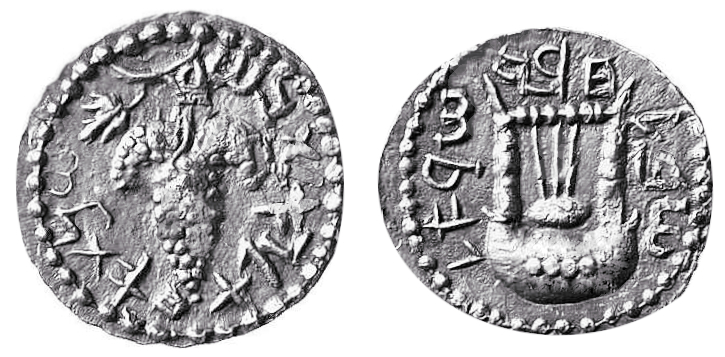 Fig. 1
Fig. 1
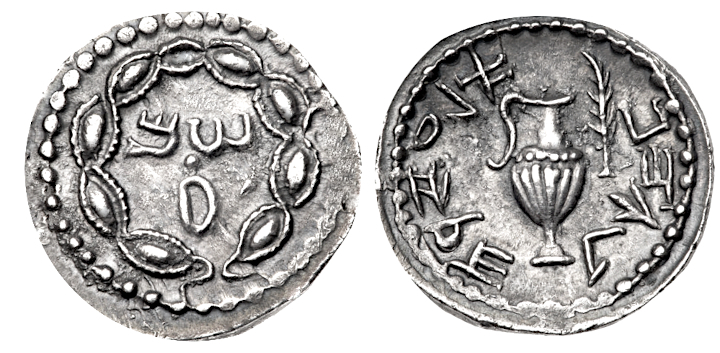 Fig. 3
Fig. 3 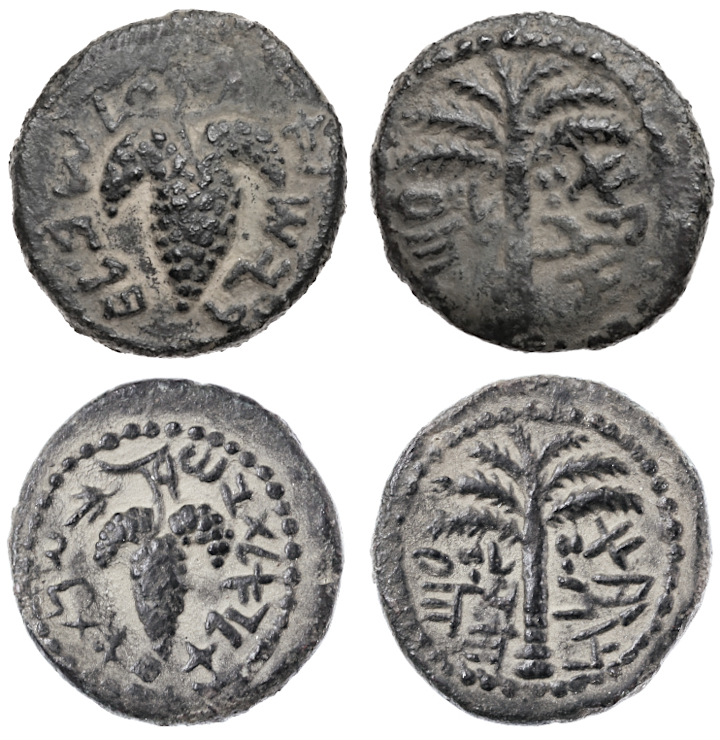 Fig. 2 (same reverse die)
Fig. 2 (same reverse die)
Hendin (Guide to Biblical Coins – 5th ed., 2021, pp. 350 – 351) introduces a 4th type of Hybrid, where the die links do not specifically match up with different years, but where the design type was otherwise utilized in a particular year. (Fig. 4) It is not clear though, that these are actually hybrids.
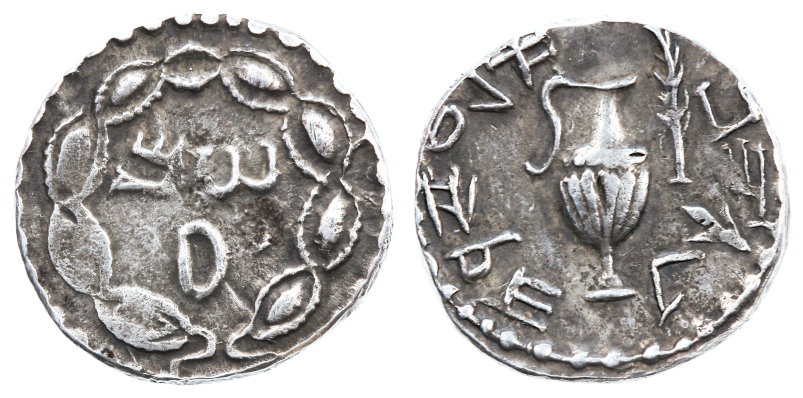 Fig. 4
Fig. 4
Yaakov Meshorer (Treasury of Jewish Coins, 2001, pp. 153) generally agrees with Hendin, stating “All of the denarii bearing the name of Eleazar the priest are hybrids”. In discussing the hybrid denarii of the second year, he explains, “were struck only because their dies from the first year had been preserved, and no new dies bearing his name were made later on”. But then he immediately qualifies that assertion, stating, “perhaps with the exception of a single one from the beginning of the second year….on which said inscription begins at the bottom right, has not yet been found on a denarii struck in the first year.”
It would appear that Meshorer’s statement that no new dies of the original format were made after the first year is speculative, as Mildenberg lists five new Eleazar dies, with the majority of them not sharing an obverse year one die at all. In fact, Mildenberg simply attributes them as year two coins; though to be fair, he does not categorize hybrid coins at all.
Turning to the bronze, we find hybrids for the medium and small denominations. In all cases, the design of one die is changed by shortening the inscription, if only by a bit. According to the Mildenberg tables, it is the obverse that is shortened on the small denomination. Both the obverse and reverse are shortened on the medium denominations. The medium denominations were struck as two types, the palm branch in wreath / lyre, and the vine leaf / palm tree.
Of particular note is this die set of the bronze medium denomination (Fig. 5.) Meshorer mentions it in his catalog (TJC, pp. 250 #257) as a hybrid. However, the larger numismatic community which can usually be counted on to point out hybrids (as they are likely to fetch higher values on the market), has neglected to mention that this die is a hybrid. In fact, it is the only known die pair for the vine leaf / palm tree bronze to be a hybrid, pairing a year two obverse with a reverse already used with a year one die. This reverse was produced later in year one, substituting the lengthy “Simon Prince of Israel” inscription for the simple three letters S M A, abbreviating the name of Simon. Sometime during year two another change was made, when a decision was taken to expand the abbreviation to the full five letter name of Shimon. This also demonstrates that the minters were not averse to making design changes mid-year.
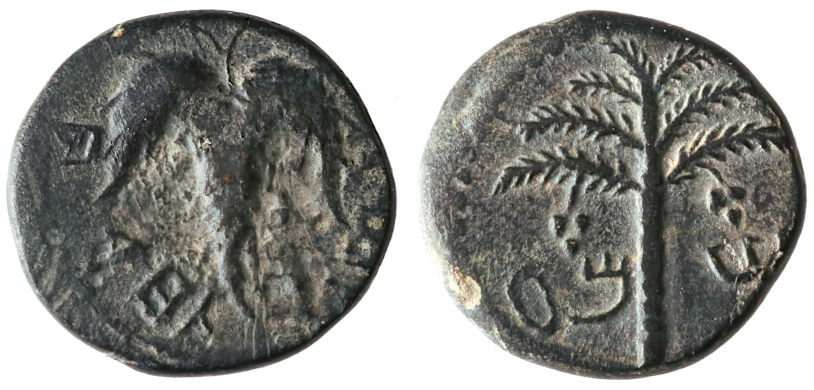 Fig. 5
Fig. 5
This coin thus establishes that the S M A design was likely created at the end of year one. Although there is precedent in the silver coinage for a coin to carry two dates as a hybrid (Fig. 1), this peculiarity exists for only two die sets (utilizing the same reverse) whose coins were struck in limited numbers. In our case, it is unlikely that they continued using year one obverse dies in year two, especially since this was a mass issue and a plethora of year two dies were produced. It is more logical that the decision to shorten the legend of these coins was taken sometime during year one, at which point the new dies were produced. A year one die was then paired with this reverse and struck.
Similarly with the denarii we find the newly debuted three letter S M A legend coupled with the Eleazar reverse which was introduced in year one. Indeed, the first instance of this S M A die (Mild. O3) was a pairing with a definite year one Eleazar die (Mild. O1), and so although not dated on either side, may also have been produced at the end of year one. The subsequent die sets of the S M A / Eleazar issues, should also be reconsidered, as they may have been entirely produced at the end of year one or the beginning of year two, and may not be hybrids at all. We note that none of the subsequent Eleazar reverses (after Mild. O1) were ever paired with a dated year one die, suggesting that these later coins may not have been hybrids and were engraved and struck entirely at the beginning of year two. As mentioned above, Meshorer states in regard to another Eleazer die not linked to year one (TJC pp. 153) “…one can perhaps conclude from this that if Eleazar was indeed dismissed from his office, this occurred at the start of the second year”.


